From Headlines to Forecasts: Narrative Econometrics in Equity Markets
Abstract
1. Introduction
1.1. Motivation and Positioning: Firm-Level Narrative Econometrics in Modern Markets
1.2. Behavioral Mechanism: From Narrative to Investment Action
- Attention and salience. Repetition and coherence push themes over attention thresholds, concentrating limited attention on a small set of frames.
- Belief updating and sentiment analysis. Frames act as cognitive “shortcuts,” shaping cash flow expectations (growth stories, product cycles) and risk perceptions (legal, regulatory, security). This yields shifts in (i) Δ Et[CF] and (ii) the required returns via risk premia/left tail risk.
- Internalization through actions. As ideas spread through analysts, buy-side notes, and media coverage, investors adjust their portfolios every month to align with their views on market trends.
1.3. Testable Implications (Consistent with a Monthly Horizon)
- Growth narratives (e.g., AI-product) → higher Et[CF], positive drift, and moderate rise in idiosyncratic volatility during adoption.
- Constraint/legal narratives (e.g., antitrust) → higher downside/skew perceptions, tighter discount rates, muted or negative drift, steeper downside option skew.
- Security/reputation narratives → transient risk-premium spikes, elevated idiosyncratic volatility, weaker multiples.
2. Literature Review and Theoretical Background
2.1. Narrative Economics and Investor Expectations
2.2. Quantifying Narratives in Financial Markets
2.3. Natural Language Processing and Narrative Modeling
2.4. Recent NLP Advances for Financial Forecasting
2.5. Comparative Grounding and External Validity
2.6. Limitations, Peer Criticisms, and Our Positioning
3. Research Gaps and Objectives
4. Research Problem
5. Conceptual Model and Interlinkages
6. Materials and Methods
6.1. Conceptual and Empirical Justification of the Methodology
6.1.1. Inclusion/Exclusion Criteria
6.1.2. Coverage Considerations
6.1.3. Temporal Aggregation Rationale (Monthly Design)
6.2. Topic Modeling with BERTopic
- is the density level at which data point leaves the cluster;
- denotes the density at which Cluster C first appears.
6.3. Sentence Encoders, Domain Adaptation, and Model Choice
6.3.1. Alternatives
6.3.2. Domain Adaptation Safeguards
6.3.3. Intrinsic Validation (Clustering Quality)
6.3.4. Reason for Selecting These Metrics
6.3.5. Extrinsic Validation
6.3.6. Evaluation and Sensitivity Analysis
6.3.7. Model Selection and Null Results Policy
- Dimensionality and hubness. AMiniLM’s 384-dimensional space exhibits less high-dimensional hubness/anisotropy than PMPNet’s higher-dimensional space, aiding density-based separation and reducing spurious topic-bridges.
- Granularity and synonymy. As a distilled similarity-oriented model, AMiniLM is less sensitive to minor word-order/phrase variants, which helps consolidate technology/product synonyms (e.g., “Copilot,” “GenAI,” “GPT-based features”) into a single, persistent narrative rather than several micro-topics.
6.4. Topic Governance and Labeling Protocol
- Unsupervised extraction of features. Topics are discovered with BERTopic (transformer embeddings) using fixed random seeds and pre-specified hyperparameters; no firm-specific heuristics are used.
- Objective retention. A topic is retained if it meets (i) coherence ≥ τ and (ii) monthly activation prevalence ≥ p% of months. Highly redundant topics are filtered when the monthly activation series correlation with an already retained topic exceeds |ρ| ≥ r.
- Deterministic labeling. Each retained topic receives a deterministic label built from its top c-TF-IDF words plus a concise domain tag (e.g., “AI Strategy and Ecosystem”), appended to the topic ID (e.g., NP01,—MSFT Stock and Market Performance).
- Transparency. We provide an appendix table with ID–label mapping and top-k keywords to enable independent auditing or relabeling.
7. Financial Narrative Structures and Temporal Dynamics
7.1. Terminology and Narrative Taxonomy
7.2. Narratives Identified by PMPNet Embeddings
7.3. Narratives Identified by AMiniLM Embeddings
8. Integrating Narrative Intensity and Regime Dynamics: From Decay-Based Modeling to Binary Activation
9. Narratives’ Binary Activation
9.1. Narratives’ Binary Activation by PMPNet
9.2. Narratives’ Binary Activation by AMiniLM
10. Discussion of Cross-Model Comparison: AMiniLM vs. PMPNet in Narrative Extraction
10.1. Empirical Comparison: Coverage, Persistence, and Collinearity
10.2. Interpreting Encoder-Specific Findings: Investor Attention and Market Response
- Salience and coherence thresholds. Narrative effects materialize when stories are coherent and consistently signaled to the audience. AMiniLM consolidates semantically close headlines into single, salient themes, whereas PMPNet’s finer granularity splits these into multiple micro-topics that individually fail to clear the attention threshold at the monthly horizon.
- Horizon mismatch and netting out. Fine-grained narratives often matter over days around events (earnings, product launches, legal filings), but net out within a month because of overreactions, reversals, and liquidity provisions. Monthly ARIMA-X therefore favors persistent themes over micro-stories.
- Category learning (information compression): Investors cognitively organize firm news into compact categories (e.g., AI product pipelines and antitrust/legal risks). The representation geometry of AMiniLM yields fewer, more stable clusters that approximate these categories, thereby increasing signal persistence. Over-segmented micro-topics disperse attention and weaken pricing power.
- Narrative competition and collinearity. When semantically adjacent micro-topics co-occur in a month, they compete in regressions and introduce multicollinearity, reducing statistical power, even if the underlying economic effect is common to them.
- Media-style heterogeneity vs. Economic content. PMPNet preserves subtle phraseological differences across different outlets. At a monthly cadence, such stylistic variation can inflate fragmentation without adding distinct economic information, whereas AMiniLM downweights microvariation and emphasizes the economic core of the storyline.
10.3. When Might PMPNet Be Preferable?
11. Empirical Modeling Results
11.1. Economic Interpretation of the Coefficients
11.2. ARIMA-X Modeling of Microsoft Returns Using Decay-Based Narrative Time Series
11.3. ARIMA-X Modeling Using Binary Narrative Activation: Threshold-Based Impact Assessment on MSFT Returns
12. Discussion of Empirical Modeling Results
12.1. Enhancing Explanatory Power with Embedding-Based Narrative Variables in ARIMA-X Models
12.2. Confounding Factors and Interpretation of the Results
12.3. Alternative Explanations Include the Following
12.4. Scope and Future Identification
12.5. Methodological Trade-Offs in Narrative Temporal Encoding
12.6. Statistical and Behavioral Implications
13. Practical and Theoretical Insights
13.1. Mechanism and Modeling Implications: Attention, Persistence, and Design Choices
- Stories using decay models, particularly those created using AMiniLM embeddings, provided the strongest and most understandable signals. They are best suited for identifying narrative momentum and persistence, especially in innovation or risk-sensitive discourse.
- Binary presence models complement decay-based methods by identifying sharp, high-intensity narrative spikes. Setting the correct thresholds is important: the 10% rule ensures that the signals are clear but might miss the effects that occur later or are spread out, whereas the 5% rule covers a longer time but can cause more background noise and confusion in the data.
- Narrative type matters. MPP narratives consistently emerged as statistically significant predictors, regardless of the threshold or embedding model. These findings validate the narrative economics claim that reputation, trust, and communication shape investor sentiment in ways distinct from traditional fundamentals or macroeconomic indicators.
- The embedding architecture was sequential in nature. AMiniLM provides better topic organization, is easier to understand, and performs better than paraphrase models in creating useful econometric features.
- Hybrid strategies that combine decay-based weighting with binary filtering or rolling window methods can improve the results by considering both rapid changes and long-term feelings.
- The results support the use of different methods that focus on meaning in narrative econometrics, in which model design, embedding selection, and timing are all closely aligned with the way financial markets operate.
13.2. Operational Guidance for Industry and Policy
13.2.1. Investors (Narrative Indices)
13.2.2. Financial Institutions (Risk Models)
13.2.3. Policymakers (Monitoring)
14. Conclusions
15. Limitations
- Activation Design (Binary Baseline): We deliberately use binary narrative activations to target the structural presence of slow-moving negative themes at a monthly horizon and avoid overfitting in a single-firm sample size. The pipeline is modular: we outline intensity-aware extensions (valence-weighted and arousal indices) and context metrics (dispersion and month-to-month shifts) that can be estimated from the same topic assignment. These measures complement, rather than replace, the binary baseline by isolating amplitude and reframing dynamics. Evaluating their incremental value relative to the binary specification is reserved for future work.
- Model Form and Identification Limits: The estimates are reduced-form and linear-additive; they assume the weak exogeneity of the narrative series and stationarity of the residuals. With T = 50 monthly observations, the order selection and coefficients are subject to small-sample uncertainty and model selection risk. Narrative activations are measured with error, can be collinear with macro controls, and are sensitive (though not fragile) to activation rules (binary thresholds/decay half-life). Monthly aggregation improves alignment with controls but can smoothen short-lived relations. Therefore, we applied Holm adjustments, treated non-significant results as null, and avoided structural claims.
- Temporal Granularity: The analysis was conducted on monthly data, which may not fully capture the high-frequency dynamics through which narrative shocks and price adjustments unfold over days or weeks. While future studies could benefit from employing weekly or daily data to better model fast-moving market responses, it is also important to acknowledge that narratives typically do not change abruptly. Unlike price movements, which may react quickly to information, they tend to evolve gradually, reflecting sustained shifts in discourse, sentiment, and thematic focus. Therefore, a monthly resolution remains appropriate for capturing the structural and behavioral trajectories of narrative influence over time.
- Embedding Model Constraints: Although AMiniLM and PMPNet provide strong semantic foundations, no embedding model is perfect. Limitations in capturing domain-specific finance language or emerging slang can affect the granularity of topic clustering.
- Narrative Decay Assumptions: The exponential decay model assumes that the influence of a narrative gradually fades away. However, its assumptions may be too simple for real-life investor reactions, in which feelings can suddenly change or become stronger.
- Binary Thresholding Sensitivity: The choice of 5% or 10% thresholds for binary narrative presence is arbitrary and could influence the results. Different threshold calibrations or dynamic thresholding strategies may yield further refinements.
- Single-Stock Focus: Focusing only on Microsoft (MSFT) provides detailed insights, but more evidence is needed to determine whether these insights apply to other companies, industries, or economic situations.
- Narrative Interpretation Subjectivity: Despite the methodological rigor in topic modeling, the manual interpretation and labeling of narratives still involve an element of researcher subjectivity that may introduce bias.
Author Contributions
Funding
Institutional Review Board Statement
Informed Consent Statement
Data Availability Statement
Conflicts of Interest
Abbreviations
| AI | Artificial Intelligence |
| AIC | Akaike Information Criterion |
| ADF | Augmented Dickey–Fuller |
| AISE | AI Strategy & Ecosystem (narrative family) |
| AMiniLM | all-MiniLM-L6-v2 (sentence-embedding model) |
| API | Application Programming Interface |
| ARCH | Autoregressive Conditional Heteroskedasticity |
| ARIMA | Autoregressive Integrated Moving Average |
| ARIMA-X | Autoregressive Integrated Moving Average with Exogenous Variables |
| BERT | Bidirectional Encoder Representations from Transformers |
| BIC | Bayesian Information Criterion |
| CECL | Current Expected Credit Loss |
| CME | Currency & Macro Environment (narrative family) |
| c-TF-IDF | Class-based Term Frequency–Inverse Document Frequency |
| c_v | Topic coherence metric (BERTopic) |
| ECL | Expected Credit Loss |
| EFC | Earnings & Financial Communication (narrative family) |
| EPS | Earnings Per Share |
| EPU | Economic Policy Uncertainty |
| FX | Foreign Exchange |
| FNM | (Growth/)Momentum narrative index |
| FRE | Financial Reports & Earnings (narrative family) |
| GARCH-X | Generalized Autoregressive Conditional Heteroskedasticity with Exogenous Variables |
| GDELT | Global Database of Events, Language, and Tone |
| HDBSCAN | Hierarchical Density-Based Spatial Clustering of Applications with Noise |
| HQIC | Hannan–Quinn Information Criterion |
| IFRS 9 | International Financial Reporting Standard 9 (Financial Instruments) |
| IR | Investor Relations |
| ITC | Industry Trends & Cloud Market (narrative family) |
| KPI | Key Performance Indicator |
| LDA | Latent Dirichlet Allocation |
| LLM | Large Language Model |
| LLR | Likelihood Ratio |
| MPP | Media & Public Perception (narrative family) |
| MQMiniLM | multi-qa-MiniLM-L6-cos-v1 (sentence-embedding model) |
| MSFT | Microsoft Corporation stock ticker symbol |
| NLP | Natural Language Processing |
| NNP | Negative Narrative Pressure (index) |
| PD | Probability of Default |
| PMiniLM | paraphrase-MiniLM-L12-v2 (sentence-embedding model) |
| PMPNet | paraphrase-MPNet-base-v2 (sentence-embedding model) |
| pp | percentage points |
| RSI | Relative Strength Index |
| SBERT | Sentence-BERT |
| SCF | Security & Conflict (narrative family) |
| SMP | MSFT Stock & Market Performance (narrative family) |
| TSE | Tech & Semiconductor Ecosystem (narrative family) |
| TTMS | Technical Trading & Market Sentiment (narrative family) |
| UMAP | Uniform Manifold Approximation and Projection |
| VAR | Vector Autoregression |
| VaR | Value at Risk |
Appendix A
| Top Keywords (Abridged) | Topic ID | Proposed Label | Topic Coherence (c_v, Unitless ∈ [0, 1]) | Start Month | End Month | Duration (Months) | Peak Monthly Docs (n) | Peak Month | Decay Parameter λ (per Month) |
|---|---|---|---|---|---|---|---|---|---|
| microsoft, nasdaq, msft, market, earnings, ai, tech | NP01 | MSFT Stock & Market Performance (SMP) | 0.456 | February 2021 | March 2025 | 50 | 1228 | March 2021 | 0.002 |
| market, global, cloud, research | NP02 | Industry Trends & Cloud Market (ITC) | 0.878 | February 2021 | March 2025 | 50 | 137 | March 2023 | 0.059 |
| crowdstrike, cybersecurity, ukraine, russia | NP03 | Security & Conflict (SCF) | 0.422 | February 2021 | March 2025 | 50 | 92 | July 2024 | 1.299 |
| openai, google, ai, search, microsoft | NP04 | AI Strategy & Ecosystem (AISE) | 0.594 | February 2021 | March 2025 | 50 | 77 | November 2023 | 0.157 |
| earnings call, investors, transcript | NP05 | Earnings & Financial Communication (EFC) | 0.228 | February 2021 | March 2025 | 50 | 45 | April 2024 | 0.362 |
| announces, street, tv, globe, media | NP06 | Media & Public Perception (MPP) | 0.752 | May 2021 | October 2024 | 42 | 7 | April 2022 | 0.172 |
| usd, forex, session, currency trends | NP07 | Currency & Macro Environment (CME) | 0.952 | October 2021 | July 2024 | 34 | 6 | July 2023 | 0.397 |
| quarterly, revenue, results, reports | NP08 | Financial Reports & Earnings (FRE) | 0.649 | February 2022 | May 2024 | 28 | 2 | February 2022 | −0.035 |
| Top Keywords (Abridged) | Topic ID | Proposed Label | Topic Coherence (c_v, Unitless ∈ [0, 1]) | Start Month | End Month | Duration (Months) | Peak Monthly Docs (n) | Peak Month | Decay Parameter λ (per Month) |
|---|---|---|---|---|---|---|---|---|---|
| microsoft, nasdaq, stocks, msft, tech, ai | NA01 | MSFT Stock & Market Performance (SMP) | 0.446 | February 2021 | March 2025 | 50 | 1244 | March 2021 | 0.001 |
| amd, processors, intel, ai | NA02 | Tech & Semiconductor Ecosystem (TSE) | 0.769 | March 2021 | March 2025 | 49 | 20 | January 2024 | 0.150 |
| usd, forex, fx, north, trading | NA03 | Currency & Macro Environment (CME) | 0.668 | October 2021 | January 2025 | 40 | 9 | April 2023 | 0.085 |
| tv, newsmax, interviews, globe | NA04 | Media & Public Perception (MPP) | 0.921 | October 2021 | December 2024 | 39 | 6 | April 2022 | 0.141 |
| quarterly, reports, earnings, results | NA05 | Financial Reports & Earnings (FRE) | 0.649 | November 2021 | March 2025 | 41 | 2 | February 2022 | 0.000 |
| pattern, hammer, selling, buy, struggling | NA06 | Technical Trading & Market Sentiment (TTMS) | 0.916 | March 2021 | March 2021 | 1 | 11 | March 2021 | - |
| mongodb, azure, ai, developer, applications | NA07 | Cloud Tools & AI Platforms (CTAIP) | 0.680 | October 2021 | December 2024 | 27 | 3 | June 2023 | 0.191 |
| Embedding | Narrative Integration | Best ARIMA (p, 0, q) | Log Likelihood (Unitless) | AIC (Unitless) | BIC (Unitless) | HQIC (Unitless) | Significant Narratives (Lag, Holm-adj. p) | LLR p-Value vs. Baseline |
|---|---|---|---|---|---|---|---|---|
| AMiniLM | Decay based | (3, 0, 3) | 76.76 | −123.5 | −95.148 | −112.76 | Media, Macro, Tech | 0.0054 |
| PMPNet | Decay based | (1, 0, 1) | 76.72 | −129.5 | −106.74 | −120.83 | No significant | <0.0001 |
| AMiniLM | Binary (10%) | (1, 0, 1) | 75.94 | −127.9 | −105.18 | −119.27 | Media (1 lag, p = 0.043) | 0.0001 |
| AMiniLM | Binary (5%) | (3, 0, 3) | 73.19 | −114.4 | −84.446 | −103.07 | Media (2 lag, p = 0.007) | 0.0076 |
| PMPNet | Binary (10%) | (2, 0, 2) | 71.36 | −112.7 | −84.042 | −101.8 | Security, AI | 0.0015 |
| PMPNet | Binary (5%) | (3, 0, 3) | 73.25 | −112.5 | −79.991 | −100.12 | Media (2 lag, p = 0.032) | 0.0011 |
| Baseline | No Narratives and EPU | (1, 0, 1) | 68.49 | −131 | −125.23 | −128.79 | – | – |
References
- Akerlof, G., & Shiller, R. (2010). Animal spirits: How human psychology drives the economy, and why it matters for global capitalism. Princeton University Press. [Google Scholar]
- Baker, S. R., Bloom, N., & Davis, S. J. (2016). Measuring economic policy uncertainty. Quarterly Journal of Economics, 131(4), 1593–1636. [Google Scholar] [CrossRef]
- Bernanke, B. S. (1983). Irreversibility, uncertainty, and cyclical investment. Quarterly Journal of Economics, 98(1), 85–106. [Google Scholar] [CrossRef]
- Bhargava, R., Lou, X., Ozik, G., Sadka, R., & Whitmore, T. (2023). Quantifying narratives and their impact on financial markets. Journal of Portfolio Management, 49(5), 82–95. [Google Scholar] [CrossRef]
- Blanqué, P., Ben Slimane, M., Cherief, A., Le Guenedal, T., Sekine, T., & Stagnol, L. (2022). The benefit of narratives for prediction of the S&P 500 Index. Journal of Financial Data Science, 4, 72–94. [Google Scholar] [CrossRef]
- Bloom, N. (2009). The impact of uncertainty shocks. Econometrica, 77, 623–685. [Google Scholar] [CrossRef]
- Boudoukh, J., Feldman, R., Kogan, S., & Richardson, M. (2013). Which news moves stock prices? A textual analysis (NBER Working Paper No. 18725). National Bureau of Economic Research. [Google Scholar] [CrossRef]
- Campello, R. J. G. B., Moulavi, D., Zimek, A., & Sander, J. (2015). Hierarchical density estimates for data clustering, visualization, and outlier detection. ACM Transactions on Knowledge Discovery from Data, 10(1), 1–51. [Google Scholar] [CrossRef]
- Damodaran, A. (2017). Narrative and numbers: The value of stories in business. Columbia University Press. [Google Scholar] [CrossRef]
- Das, R. C. (2020). Forecasting incidences of COVID-19 using Box–Jenkins method for the period July 12–September 11, 2020: A study on highly affected countries. Chaos Solitons Fractals, 140, 110248. [Google Scholar] [CrossRef]
- Deveikyte, J., Geman, H., Piccari, C., & Provetti, A. (2022). A sentiment analysis approach to the prediction of market volatility. Frontiers in Artificial Intelligence, 5, 836809. [Google Scholar] [CrossRef]
- Du, K., Zhao, Y., Mao, R., Xing, F., & Cambria, E. (2025). Natural language processing in finance: A survey. Information Fusion, 115, 102755. [Google Scholar] [CrossRef]
- Grootendorst, M. (2022). BERTopic: Neural topic modeling with a class-based TF-IDF procedure. Available online: https://arxiv.org/abs/2203.05794 (accessed on 12 August 2025).
- Hassan, T. A., Hollander, S., van Lent, L. A. G. M., & Tahoun, A. (2019). Firm-level political risk: Measurement and effects. Quarterly Journal of Economics, 134, 2135–2202. [Google Scholar] [CrossRef]
- Jegadeesh, N., & Wu, D. (2013). Word power: A new approach for content analysis. Journal of Financial Economics, 110, 712–729. [Google Scholar] [CrossRef]
- Kahneman, D., & Tversky, A. (1979). Prospect theory: An analysis of decision under risk. Econometrica, 47(2), 263–291. [Google Scholar] [CrossRef]
- Karlsson, N., Loewenstein, G., & Seppi, D. (2009). The ostrich effect: Selective attention to information. Journal of Risk and Uncertainty, 38, 95–115. [Google Scholar] [CrossRef]
- Knight, F. H. (1921). Risk, uncertainty and profit. Houghton Mifflin Company. [Google Scholar]
- Loughran, T., & McDonald, B. (2011). When is a liability not a liability? Textual analysis, dictionaries, and 10-Ks. Journal of Finance, 66, 35–65. [Google Scholar] [CrossRef]
- Mangee, N. (2021). How novelty and narratives drive the stock market. Cambridge University Press. [Google Scholar]
- McInnes, L., Healy, J., & Melville, J. (2018). UMAP: Uniform manifold approximation and projection for dimension reduction. arXiv. [Google Scholar] [CrossRef]
- Pastor, Ľ., & Veronesi, P. (2013). Political uncertainty and risk premia. Journal of Financial Economics, 110(3), 520–545. [Google Scholar] [CrossRef]
- Piper, A., So, R. J., & Bamman, D. (2021, November 7–11). Narrative theory for computational narrative understanding. 2021 Conference on Empirical Methods in Natural Language Processing (pp. 298–311), Virtual Event/Punta Cana, Dominican Republic. [Google Scholar] [CrossRef]
- Roos, M., & Reccius, M. (2023). Narratives in economics. Journal of Economic Surveys, 38(2), 303–341. [Google Scholar] [CrossRef]
- Schank, R. C., & Abelson, R. P. (1977). Scripts, plans, goals, and understanding: An inquiry into human knowledge structures. Lawrence Erlbaum. [Google Scholar]
- Shiller, R. J. (2017). Narrative economics. American Economic Review, 107(4), 967–1004. [Google Scholar] [CrossRef]
- Shiller, R. J. (2019). Narrative economics: How stories go viral and drive major economic events. Princeton University Press. [Google Scholar]
- Taffler, R. J., Agarwal, V., & Obring, M. (2024). Narrative emotions and market crises. Journal of Behavioral Finance. [CrossRef]
- Tetlock, P. C. (2007). Giving content to investor sentiment: The role of media in the stock market. Journal of Finance, 62(3), 1139–1168. [Google Scholar] [CrossRef]
- Tetlock, P. C., Saar-Tsechansky, M., & Macskassy, S. (2008). More than words: Quantifying language to measure firms’ fundamentals. Journal of Finance, 63, 1437–1467. [Google Scholar] [CrossRef]
- Tuckett, D., & Nikolic, M. (2017). The role of conviction and narrative in decision-making under radical uncertainty. Theory and Psychology, 27(4), 501–523. [Google Scholar] [CrossRef] [PubMed]
- Wu, S., Irsoy, O., Lu, S., Dabravolski, V., Dredze, M., Gehrmann, S., Kambadur, P., Rosenberg, D., & Mann, G. (2023). BloombergGPT: A large language model for finance. arXiv. [Google Scholar] [CrossRef]
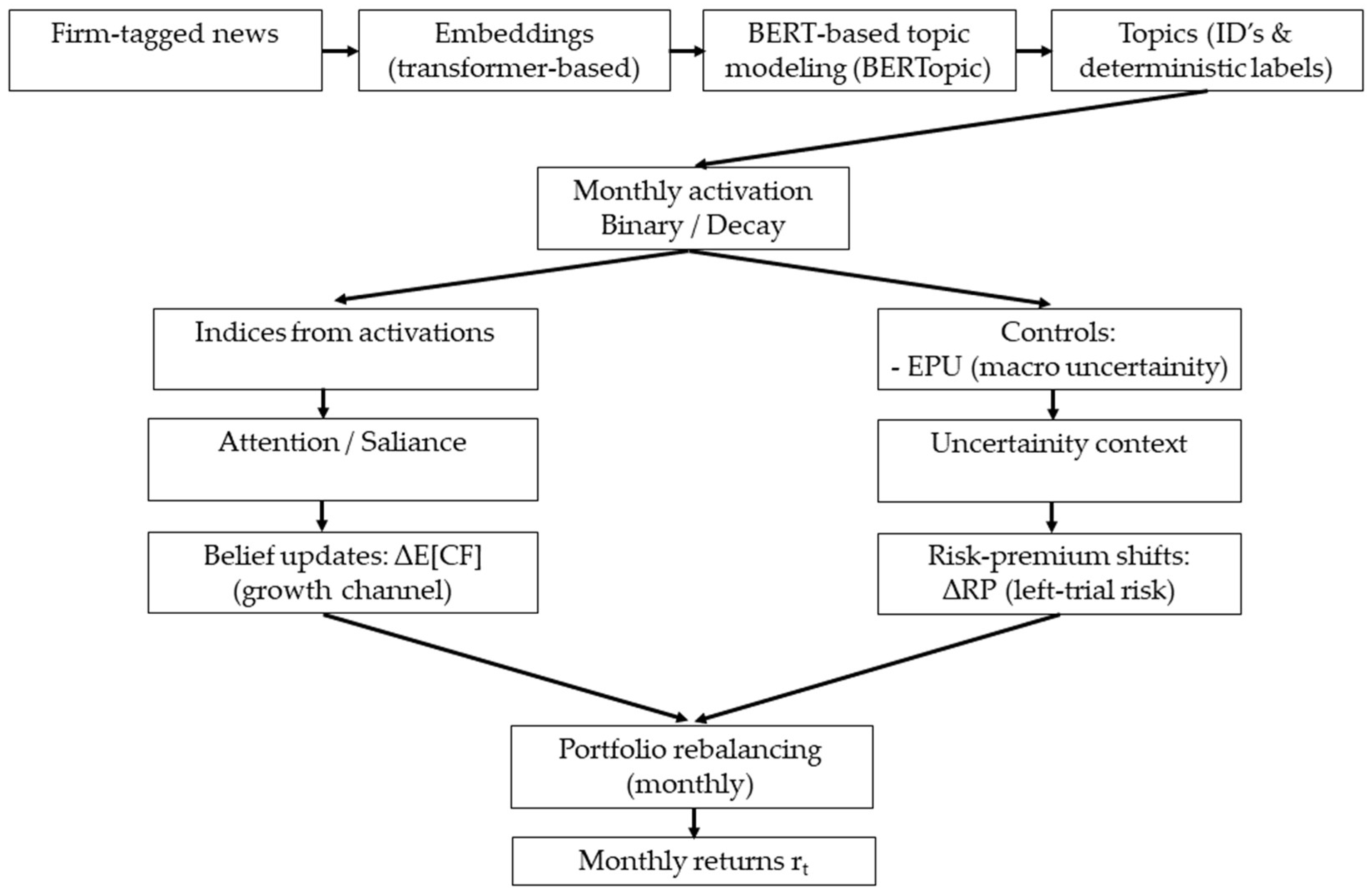
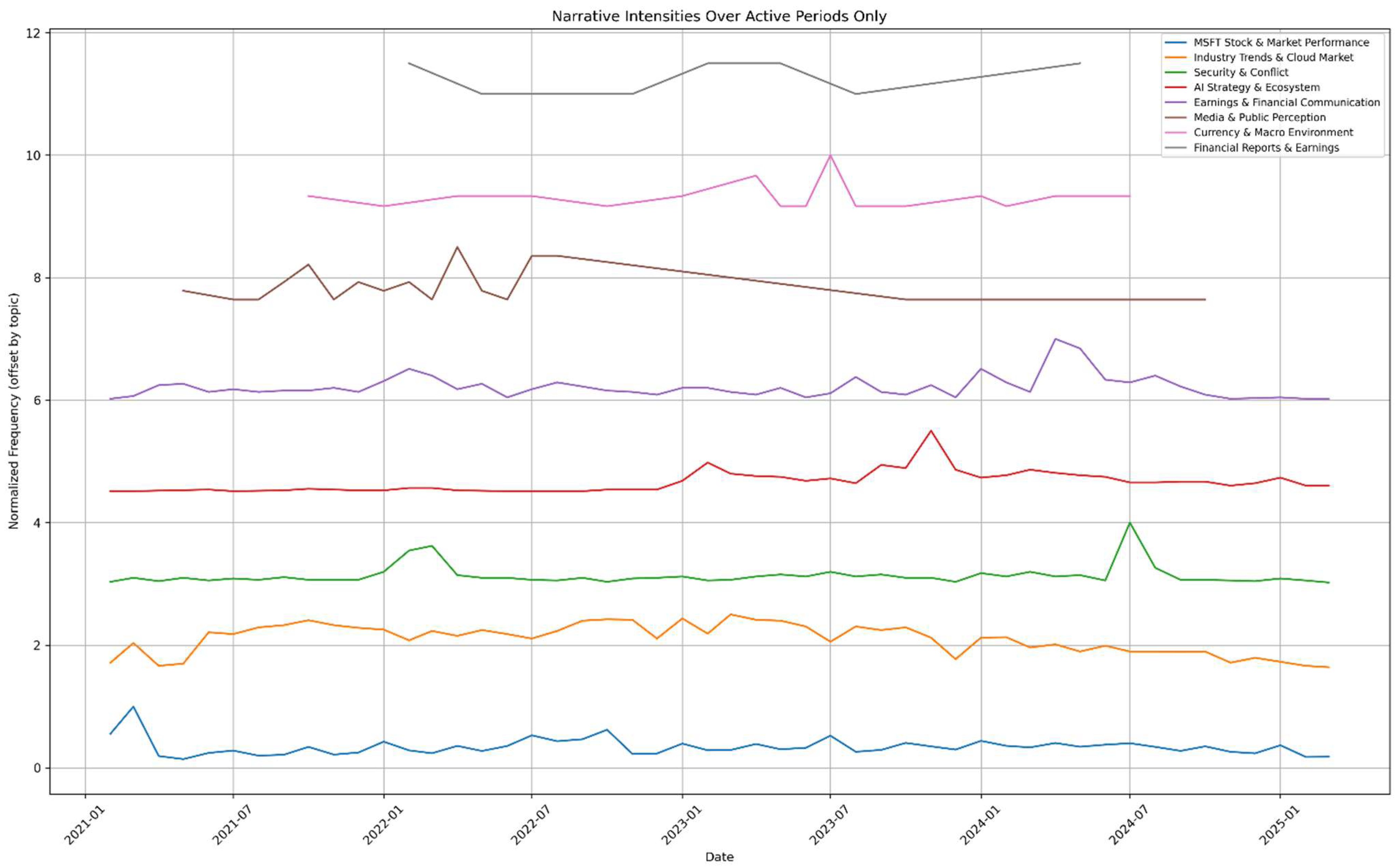


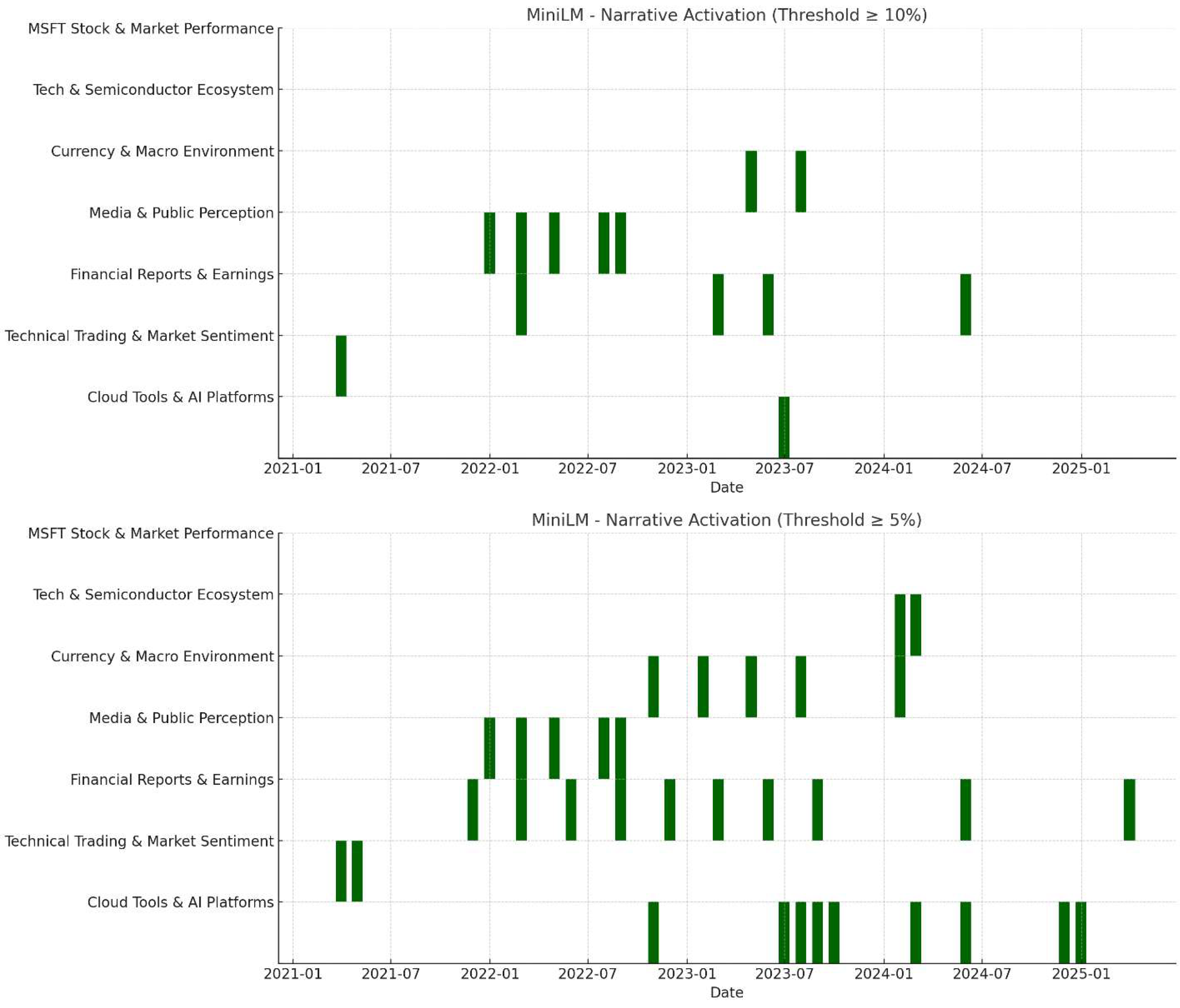
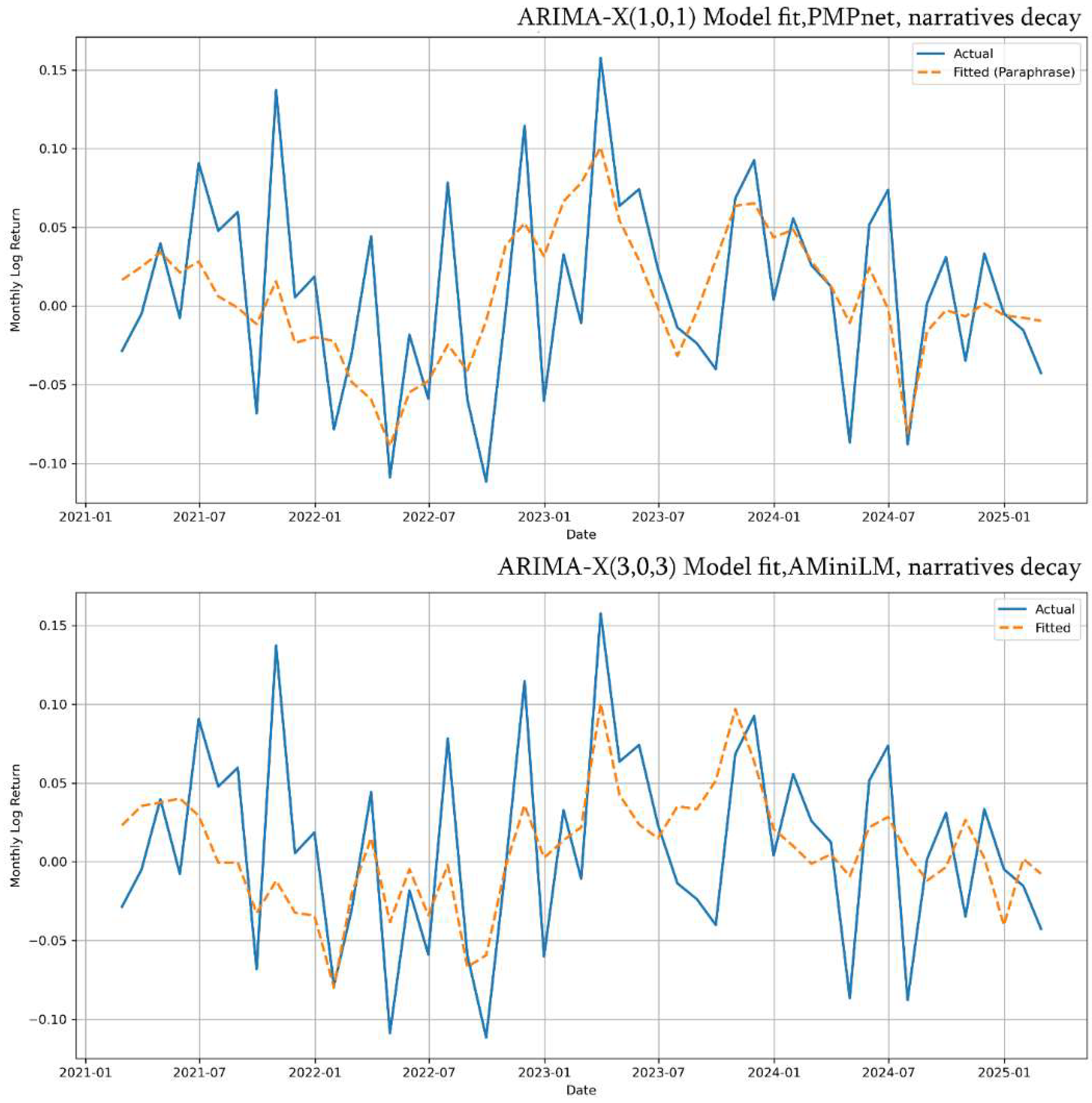
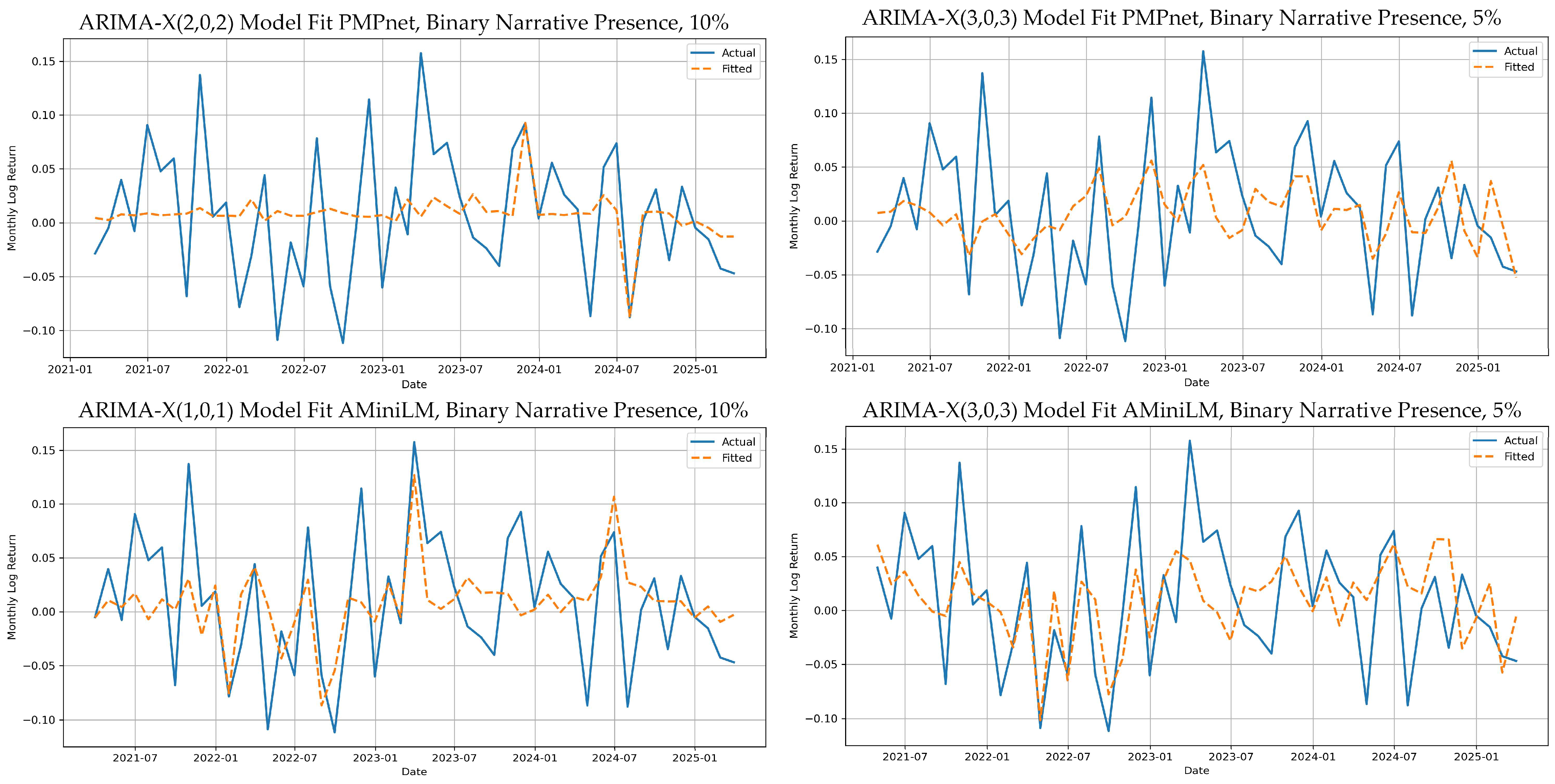
| Model | Silhouette Score | Topic Coherence (c_v) |
|---|---|---|
| PMPNet | –0.019 | 0.580 |
| AMiniLM | 0.016 | 0.537 |
| PMiniLM | 0.047 | 0.495 |
| MQMiniLM | 0.002 | 0.486 |
Disclaimer/Publisher’s Note: The statements, opinions and data contained in all publications are solely those of the individual author(s) and contributor(s) and not of MDPI and/or the editor(s). MDPI and/or the editor(s) disclaim responsibility for any injury to people or property resulting from any ideas, methods, instructions or products referred to in the content. |
© 2025 by the authors. Licensee MDPI, Basel, Switzerland. This article is an open access article distributed under the terms and conditions of the Creative Commons Attribution (CC BY) license (https://creativecommons.org/licenses/by/4.0/).
Share and Cite
Hayrapetyan, D.; Gevorgyan, R. From Headlines to Forecasts: Narrative Econometrics in Equity Markets. J. Risk Financial Manag. 2025, 18, 524. https://doi.org/10.3390/jrfm18090524
Hayrapetyan D, Gevorgyan R. From Headlines to Forecasts: Narrative Econometrics in Equity Markets. Journal of Risk and Financial Management. 2025; 18(9):524. https://doi.org/10.3390/jrfm18090524
Chicago/Turabian StyleHayrapetyan, Davit, and Ruben Gevorgyan. 2025. "From Headlines to Forecasts: Narrative Econometrics in Equity Markets" Journal of Risk and Financial Management 18, no. 9: 524. https://doi.org/10.3390/jrfm18090524
APA StyleHayrapetyan, D., & Gevorgyan, R. (2025). From Headlines to Forecasts: Narrative Econometrics in Equity Markets. Journal of Risk and Financial Management, 18(9), 524. https://doi.org/10.3390/jrfm18090524









